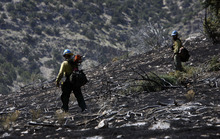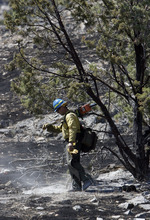This is an archived article that was published on sltrib.com in 2012, and information in the article may be outdated. It is provided only for personal research purposes and may not be reprinted.
Two years ago, firearm use caused 20 wildfires in Utah. Last year, the number ticked up to 24.
This year, with roughly three months of dry season to go, officials have already attributed 19 fires toshooting guns.
"This year's the polar opposite of last year," said state fire marshal Brent Halladay. "Last year, you had to work to get a fire going. If you spit wrong, you're gonna get a fire this year."
In the past, such fires started in May or June and ended in late September. This year, firearm use began causing fires throughout the state as early as February. Low precipitation, dry heat and high winds have hit the West hard, exacerbating the risk that bullets may glance off rocks and create sparks.
Despite the increasing problem, local agencies are stuck in a legal quandary.
Utah code 76-10-500, passed in 1999, states: "Unless specifically authorized by the Legislature by statute, a local authority or state entity may not enact or enforce any ordinance, regulation, or rule pertaining to firearms." A 2004 law contains similar phrasing.
This means that while federal entities and cities can impose fire safety restrictions — Provo has banned all open burning within its boundaries, and target shooting is permitted only at the gun club — the law effectively hamstrings state organizations. Any curtailing of target shooting must be done through the Legislature, a difficult task given Utah's entrenched gun culture.
A March report by The Daily Beast ranked Utah as the second-most armed state in the country. Data from the FBI's National Instant Criminal Background Check System indicated that 46,898 checks in connection with gun sales had been done per 100,000 Utah residents over an 18-month span, behind only Kentucky. The metric is certainly imperfect: different states are not uniformly consistent in reporting data, and may or may not apply background checks to private sales.
Still, the fact remains that, 1) the Beehive State has some of the more liberal gun laws in the country and, 2) many Utahns are thankful for them.
But the state's zealous protection of gun rights leaves fire prevention to the discretion of individuals — a freedom that allows for the careless to shoot into dry hills and rocks. When bullets strike rock, heated fragments can break off. If the fragments make contact with dry grass, which can burn at 450 to 500 degrees, the right conditions can lead to wildfires.
Officials say that when they perform fire investigations, they exhaustively rule out causes like campfires, power lines or smoking before closing a case. Reports include witness accounts and evidence found at the scene. The standard is that the evidence will hold up in court.
"It's basically CSI in the wildfire world," said Jason Curry, public information officer for the Utah Division of Forestry, Fire and State Lands. "It's not easy [to start a fire with guns]. A lot of people will go their whole lives shooting guns in dry rocks without incident, but it can happen."
Cpl. Todd Johnson of the Utah Highway Patrol said that while tracer rounds and exploding targets cause greater concern, the possibility for regular ammunition to cause fires still exists.
Nevertheless, some are doubtful of the state's official findings. Clark Aposhian, chairman of the Utah Shooting Sports Council (USSC), isn't ruling out shooting as causes for the fires, but pointed out that recreational activities like camping carry fire risks as well.
In his organization's tests — which Aposhian compared to the Discovery show "Mythbusters" — steel-jacketed and steel-core bullets created some sparks, but copper- and lead-jacketed bullets did not.
"We are certainly not apologists for people acting irresponsibly," he said. "It's not a problem inherent in shooting. It's a problem in judgment."
Curry said that while he hasn't personally seen lead bullets spark fires this year, they have in previous years. He added that if the Division of Forestry were to consider imposing restrictions on shooting, which it is currently unable to do, steel ammunition would be the first target.
In an upcoming email release, the USSC urges hunters and shooters to select targets cautiously this summer. The Division of Forestry is currently consulting with state legislators and attorneys to decide its next course of action in attempting to reduce firearm-caused wildfires.





